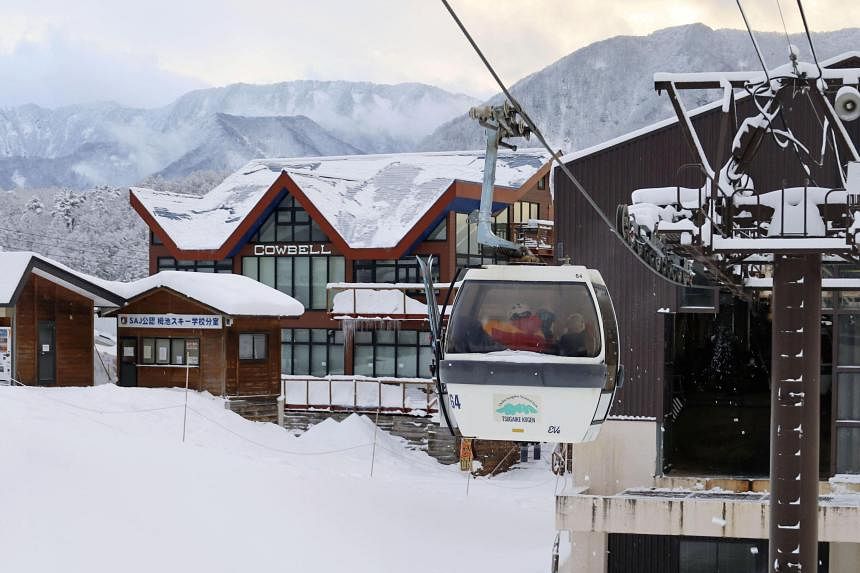TOKYO – Japan may be known for its powder snow, but this belies the peril, with both foreign tourists and locals killed in accidents and avalanches this winter.
Two Singaporeans died in a car crash in Hokkaido last month, while the risks of back-country skiing were underscored last week when an avalanche in Nagano killed an American former world champion skier.
While it is premature to say if numbers have increased compared with those of previous years, the deaths, which coincide with the return of tourists to Japan after border restrictions were eased last October, have thrown a spotlight on the inherent danger of winter weather. Locals have also died, and officials are urging extreme vigilance on frosty roads and snowy slopes.
On Jan 10, Singaporeans Lin Xiuyue, 41, and her four-month-old daughter, Aahana Karthik, died after their rental car slammed into a dump truck at an intersection. Her husband, Mr Karthik Balasubramanian, 44, and three-year-old daughter Aanya, survived with injuries.
Mr Karthik, who was behind the wheel, told The Straits Times that snow was piled up on both sides of the road, and conditions had not allowed him to get a good view of the intersection, which was not shown on his GPS navigation system. He braked when he noticed the stop sign, but it was too late.
According to data from the Hokkaido Prefectural Police, there were 80 traffic accidents involving foreign tourists, including 34 head-on collisions, from 2018 to 2022. About 70 per cent of the accidents occurred during winter from December to March.
Local media reports suggest insufficient understanding of Japan’s traffic laws – unlike the octagon stop signs in many other jurisdictions, Japan’s stop signs are shaped in an inverted triangle – and an unfamiliarity with driving in icy conditions.
The stop signs, hitherto only in Japanese, are being replaced nationwide to include English. But budget constraints mean only 5,000 of the 106,000 signs in Hokkaido have been changed so far, the Hokkaido Shimbun newspaper reported.
The pristine back-country of Japan, which has legions of fans among powder snow enthusiasts, is also potentially fatal.
These unmanaged and unpatrolled mountainous areas are outside ski resorts, which groom their ski runs to prevent avalanches. Such remote untrodden reaches with their soft snow have a particular appeal for adrenaline-seekers.

In the winter of 2019-2020, just before the pandemic closed borders, a rise in foreign tourist ski deaths and accidents had put pressure on the country’s resort industry.
The National Police Agency said it handled 140 back-country incidents in 2018, including 61 involving foreigners. This rose to 164 cases in 2019, with 50 involving foreigners, before falling to 95 cases in 2020, including 31 involving foreigners.
This year, there have already been a number of high-profile deaths.
Former halfpipe world champion Kyle Smaine, 31, and Austrian national Christoph Schoefegger, 30, died on Jan 29 when they were swept up in an avalanche at 2,100m above sea level on Mount Hakuba-Norikuradake.
On Jan 13, a German female skier died after she was buried in an avalanche on Niseko’s iconic Mount Yotei. There were also local fatalities, including a 38-year-old skier in Nagano on Jan 28 and a 46-year-old snowboarder in Gunma a day later.

Others were luckier. Four Finnish men, reported missing on Jan 29 under blizzard conditions in the Myoko mountain range in Niigata, managed to make it down safely a day later. On Jan 31, three Japanese back-country skiers survived an avalanche on Tottori’s Mount Daisen.
The Japan Association For Skiing Safety advised back-country skiers and snowboarders to properly research weather conditions and the mountain’s topography before any expedition, and to be constantly on the alert for any avalanche advisories.
Avalanches may occur both in blizzard conditions when a layer of fresh snow slides off harder icy snow underneath (known as surface avalanches), and warm weather that leads to snow melting (known as full-depth avalanches).
The association said back-country skiers should carry gear such as an avalanche beacon, a probe and a shovel, and pack enough food for at least one night in case they run into trouble.
They are also advised to submit their plans to the local authorities in case a search-and-rescue operation is needed, and hire a licensed back-country guide if they need one.
Back-country guide Toyokazu Nakano told public broadcaster NHK: “The most important thing is to check the route and weather conditions in advance, and be equipped to spend a night in case of trouble. Proper technique and strong stamina are a must.”


